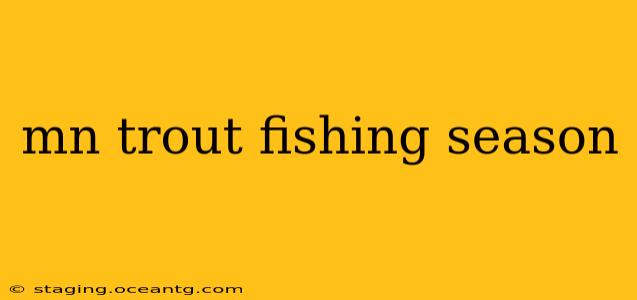Minnesota boasts a fantastic array of trout fishing opportunities, attracting anglers from across the country. However, understanding the intricacies of the Minnesota trout fishing season is crucial for a successful and legal fishing trip. This comprehensive guide covers everything you need to know, from opening dates to regulations, ensuring your next trout fishing adventure in the Land of 10,000 Lakes is both rewarding and responsible.
When is Trout Season in Minnesota?
The Minnesota trout fishing season varies depending on the specific location and the species of trout. Generally, the season opens in spring and extends through fall, but specific dates are crucial. Always check the Minnesota Department of Natural Resources (DNR) website for the most up-to-date and accurate information before you head out. Regulations change, and relying on outdated information can lead to fines. The DNR website is your best resource for confirming opening and closing dates, size and bag limits, and any special regulations for particular waters.
What are the Different Types of Trout Found in Minnesota?
Minnesota waters are home to several trout species, each with its own unique characteristics and habitat preferences. Knowing which species you're targeting can significantly impact your fishing strategy and location choices.
- Brook Trout: Known for their beautiful coloration, brook trout are often found in cooler, clearer streams and rivers.
- Brown Trout: These larger trout are typically found in lakes and larger rivers with deeper, colder waters.
- Rainbow Trout: A popular game fish, rainbow trout thrive in a variety of habitats, including rivers and lakes.
What are the Size and Bag Limits for Trout in Minnesota?
Size and bag limits for trout in Minnesota vary widely depending on the specific water body and the species of trout. These regulations are put in place to ensure sustainable fishing practices and protect trout populations. Again, consult the DNR website for the most current information on size and bag limits applicable to your chosen fishing location. Failure to adhere to these regulations can result in significant fines.
What is the best time of day to fish for trout in Minnesota?
The best time of day to fish for trout in Minnesota often depends on the weather conditions, water clarity and the specific species you’re targeting. Generally, dawn and dusk are excellent times to find trout actively feeding, as they are less wary in the lower light levels. However, cloudy days or overcast conditions can make trout active throughout the day. Experimenting with different times will help you determine the optimal fishing times for your chosen location.
What kind of bait or lures work best for Minnesota trout?
The success of your bait or lure will greatly depend on the specific species, water conditions, and time of year. Popular choices include small spinners, spoons, and various types of artificial flies. Live bait such as worms, minnows, and salmon eggs can also be effective, but always check regulations to ensure their use is permitted in your chosen location. Experimentation is key to finding what works best on a particular day.
Where are the best places to trout fish in Minnesota?
Minnesota offers a plethora of excellent trout fishing locations, from pristine streams to vast lakes. The DNR website provides detailed information on various fishing locations throughout the state, including maps, access points, and species information. Some popular areas known for exceptional trout fishing include the North Shore of Lake Superior, various streams in northern Minnesota, and certain designated trout lakes. Researching specific locations based on the species you’re targeting will significantly increase your chances of success.
What licenses and permits are required to fish for trout in Minnesota?
Before heading out, you'll need a valid Minnesota fishing license. The DNR website provides information on how to purchase licenses online or at various retailers. Depending on your fishing location and the species you are targeting, additional permits may also be required. Always check the regulations specific to your fishing area to ensure you're fully compliant with all legal requirements. Fishing without a license or the necessary permits will result in hefty fines.
By carefully studying the Minnesota DNR website and planning your trip accordingly, you can enjoy a successful and memorable trout fishing experience in Minnesota. Remember to practice responsible angling practices, always follow regulations, and respect the environment to ensure the continued health of these magnificent fish populations for generations to come.
